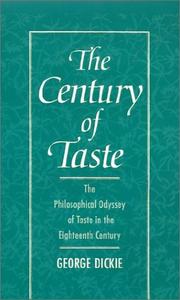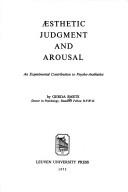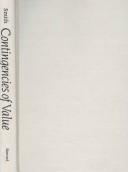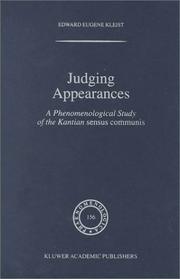| Listing 1 - 8 of 8 |
Sort by
|
Book
ISBN: 9781438461892 Year: 2016 Publisher: Albany : State University of New York Press,
Abstract | Keywords | Export | Availability | Bookmark
 Loading...
Loading...Choose an application
- Reference Manager
- EndNote
- RefWorks (Direct export to RefWorks)
Judgment (Aesthetics) --- Jugement esthétique --- Philosophy of nature --- Philosophie de la nature --- Kant, Immanuel, --- Kant, Immanuel --- Jugement esthétique. --- Philosophie de la nature. --- Philosophy of nature. --- Jugement esthétique.
Book
ISBN: 0748604391 Year: 1993 Publisher: Edinburgh Edinburgh university press
Abstract | Keywords | Export | Availability | Bookmark
 Loading...
Loading...Choose an application
- Reference Manager
- EndNote
- RefWorks (Direct export to RefWorks)
Aesthetics --- Judgment (Aesthetics) --- Criticism (Philosophy) --- Esthétique --- Jugement (Esthétique) --- Criticisme --- Philosophy --- Philosophie --- Kant, Immanuel, --- Beautiful, The --- Beauty --- Esthetics --- Taste (Aesthetics) --- Art --- Criticism --- Literature --- Proportion --- Symmetry --- Psychology --- Kant, Immanuel --- Esthétique --- Jugement (Esthétique) --- Radio broadcasting Aesthetics

ISBN: 128053365X 0195357132 9780195357134 0195096800 9780195096804 0197730051 Year: 2023 Publisher: New York ; Oxford University Press,
Abstract | Keywords | Export | Availability | Bookmark
 Loading...
Loading...Choose an application
- Reference Manager
- EndNote
- RefWorks (Direct export to RefWorks)
This is a critical account of such central figures in the early development of the modern philosophy of art as Hutcheson, Gerard, Alison, Kant and Hume. It traces the development of the modern theory of artistic taste from its origin to its refinement and complete expression.
Aesthetics, Modern --- Philosophy. --- Mental philosophy --- Humanities --- Aesthetics --- History --- 18e siècle. --- Aesthetics, Modern. --- Beau. --- Esthetica. --- Esthétique. --- Goût (Esthétique). --- Histoire. --- Jugement esthétique. --- PHILOSOPHY --- Aesthetics. --- 1700-1799. --- Aesthetics, Modern - 18th century --- Philosophy

ISBN: 9061860016 Year: 1973 Publisher: Leuven Leuven university press
Abstract | Keywords | Export | Availability | Bookmark
 Loading...
Loading...Choose an application
- Reference Manager
- EndNote
- RefWorks (Direct export to RefWorks)
Judgment (Aesthetics) --- Arousal (Physiology) --- Jugement (Esthétique) --- Eveil --- 658.8 --- 659 --- Academic collection --- Aesthetics --- Neurophysiology --- Psychophysiology --- Marketing. Sales. Selling. Distribution --- Publicity. Information work. Public relations --- Arousal (Physiology). --- Judgment (Aesthetics). --- 659 Publicity. Information work. Public relations --- 658.8 Marketing. Sales. Selling. Distribution --- Jugement (Esthétique)

ISBN: 0674167864 0674167856 9780674167865 9780674167858 Year: 1988 Publisher: Cambridge : Harvard University Press,
Abstract | Keywords | Export | Availability | Bookmark
 Loading...
Loading...Choose an application
- Reference Manager
- EndNote
- RefWorks (Direct export to RefWorks)
Jugement esthétique --- Valeurs (philosophie) --- Values. --- -Literaire kritiek --- -82.01 Esthetica --- 82.09 --- 82.01 --- Literature --- -Belles-lettres --- Western literature (Western countries) --- World literature --- 82.01 Esthetica --- Esthetica --- 82.09 Literaire kritiek --- Literaire kritiek --- History and criticism --- Aesthetics --- Values --- Axiology --- Worth --- Knowledge, Theory of --- Metaphysics --- Psychology --- Ethics --- Appraisal of books --- Books --- Evaluation of literature --- Criticism --- Literary style --- Beautiful, The --- Beauty --- Esthetics --- Taste (Aesthetics) --- Philosophy --- Art --- Proportion --- Symmetry --- Appraisal --- Evaluation --- Aesthetics. --- History and criticism. --- Critique littéraire --- Interdisciplinarité --- Esthétique --- Littérature --- Valeurs (Philosophie) --- Histoire et critique --- Critique littéraire. --- Interdisciplinarité. --- Radio broadcasting Aesthetics --- Literature - History and criticism

ISBN: 0792363108 1402002580 9401139318 9780792363101 Year: 2000 Volume: 156 Publisher: Dordrecht : Kluwer Academic,
Abstract | Keywords | Export | Availability | Bookmark
 Loading...
Loading...Choose an application
- Reference Manager
- EndNote
- RefWorks (Direct export to RefWorks)
Kant's Critique of Judgment accounts for the sharing of a common world, experienced affectively, by a diverse human plurality. In order to appreciate Kant's project, Judging Appearances retrieves the connection between appearance and judgment in the Critique of Judgment. Kleist emphasizes the important but neglected idea of a sensus communis, which provides the indeterminate criterion for judgments regarding appearance. Judging Appearances examines the themes of appearance and judgment against the background of Kant's debt to Leibniz and Shaftesbury. Drawing upon treatments by Husserl, Sartre, Ricoeur and Arendt, Kleist delineates the proto-phenomenological method through which Kant uncovers the idea of a sensus communis. Kleist shows that taste is a discipline of opening oneself to appearance, requiring a subject who dwells in a common world of appearances among a diverse human plurality. This volume will prove valuable for anyone interested in a fresh approach to themes at the heart of Kant's aesthetics.
Metaphysics --- Theory of knowledge --- Leibniz, von, Gottfried W. --- Kant, Immanuel --- Fenomenologie --- Phenomenology --- Phénoménologie --- Phenomenology. --- Judgment (Aesthetics) --- Jugement (Esthétique) --- Kant, Immanuel, --- Aesthetics. --- Academic collection --- Philosophy, Modern --- -Aesthetics --- Phénoménologie --- Jugement (Esthétique) --- Kant, Emmanuel --- Kant, Emanuel --- Kant, Emanuele --- Aesthetics --- Kant, I. --- Kānt, ʻAmmānūʼīl, --- Kant, Immanouel, --- Kant, Immanuil, --- Kʻantʻŭ, --- Kant, --- Kant, Emmanuel, --- Ḳanṭ, ʻImanuʼel, --- Kant, E., --- Kant, Emanuel, --- Cantơ, I., --- Kant, Emanuele, --- Kant, Im. --- קאנט --- קאנט, א. --- קאנט, עמנואל --- קאנט, עמנואל, --- קאנט, ע. --- קנט --- קנט, עמנואל --- קנט, עמנואל, --- كانت ، ايمانوئل --- كنت، إمانويل، --- カントイマニユエル, --- Kangde, --- 康德, --- Kanṭ, Īmānwīl, --- كانط، إيمانويل --- Kant, Manuel, --- Modern philosophy. --- Phenomenology . --- Philosophy. --- Modern Philosophy. --- History of Philosophy. --- Mental philosophy --- Humanities --- Beautiful, The --- Beauty --- Esthetics --- Taste (Aesthetics) --- Philosophy --- Art --- Criticism --- Literature --- Proportion --- Symmetry --- Modern philosophy --- Psychology
Book
ISBN: 0691071942 0691618097 1400869455 0691645132 9780691071947 Year: 2015 Publisher: Princeton, NJ : Princeton University Press,
Abstract | Keywords | Export | Availability | Bookmark
 Loading...
Loading...Choose an application
- Reference Manager
- EndNote
- RefWorks (Direct export to RefWorks)
This is a systematic study of the conceptual framework used by critics and scholars in their discussions of influence in art and literature. Göran Hermerén explores the key questions raised in scholarly debate on the topic: What is meant by "influence"? What methods can be used to settle disagreements about influence? What reasons could be used to support or reject statements about artistic and literary influence? The book is based on descriptive analyses in which the author has tried to make explicit what is said or implied in a number of "ations from scholarly writings on art and literature. Throughout, the emphasis is on clarifying the assumptions on which the use of the concept of influence is based, thus describing the limitations and merits of this kind of comparative research for critics and scholars.Originally published in 1975.The Princeton Legacy Library uses the latest print-on-demand technology to again make available previously out-of-print books from the distinguished backlist of Princeton University Press. These editions preserve the original texts of these important books while presenting them in durable paperback and hardcover editions. The goal of the Princeton Legacy Library is to vastly increase access to the rich scholarly heritage found in the thousands of books published by Princeton University Press since its founding in 1905.
Judgment (Aesthetics) --- Influence littéraire, artistique, etc. --- Jugement (Esthétique) --- Influence (Literary, artistic, etc) --- -Themes, motives. --- Judgment (Aesthetics). --- Influence littéraire, artistique, etc. --- Jugement (Esthétique) --- Art --- Influence (Literary, artistic, etc.) --- Literature --- -Artistic impact --- Artistic influence --- Impact (Literary, artistic, etc.) --- Literary impact --- Literary influence --- Literary tradition --- Tradition (Literature) --- Belles-lettres --- Western literature (Western countries) --- World literature --- Themes, motives. --- Philosophy --- Subjects --- Comparative literature --- Littérature --- Themes, motives --- Thèmes, motifs --- Philosophie --- Aesthetics --- Artistic impact --- Influence (Psychology) --- Intermediality --- Intertextuality --- Originality in literature --- Literature and philosophy --- Philosophy and literature --- Theory --- Influence (Literary, artistic, etc.). --- Philosophy. --- Art - Themes, motives --- Literature - Philosophy --- Adjective. --- Aesthetic Theory. --- Aesthetics. --- Allegory. --- Allusion. --- Anachronism. --- Ancient art. --- Anecdote. --- Antithesis. --- Art criticism. --- Art history. --- Artistic merit. --- Baroque painting. --- Caravaggio. --- Carolingian art. --- Causality. --- Cliché. --- Clinamen. --- Close reading. --- Comparative literature. --- Comparative method (linguistics). --- Contemporary art. --- Contemporary philosophy. --- Counterfactual conditional. --- Criticism. --- Cubism. --- D. H. Lawrence. --- Deed. --- Digression. --- Drapery. --- Engraving. --- Epic poetry. --- Explanation. --- Ezra Pound. --- Fine art. --- Florentine painting. --- Forgery. --- French literature. --- Genre. --- Human Action. --- Humanities. --- Iconography. --- Ideogrammic method. --- Ideology. --- Illocutionary act. --- Illusionism (art). --- Illustration. --- Illustrator. --- Imagery. --- Indian aesthetics. --- Individualism. --- Invention. --- Japanese art. --- Journalism. --- Languages of Art. --- Las Meninas. --- Literary genre. --- Literature. --- Marcel Duchamp. --- Metaphor. --- Monograph. --- Mural. --- Mutatis mutandis. --- Narrative. --- Oil sketch. --- Ontology. --- Originality. --- Overreaction. --- Pablo Picasso. --- Paul Gauguin. --- Perlocutionary act. --- Philosopher. --- Philosophy of history. --- Philosophy of language. --- Plagiarism. --- Poetry. --- Publication. --- Publishing. --- Rapprochement. --- Requirement. --- Result. --- Romanticism. --- Secondary source. --- Speech act. --- Still life. --- Stipulation. --- Stipulative definition. --- Suggestion. --- Symbolism (arts). --- The Conceptual Framework. --- Theory of art. --- Theory. --- Thought. --- Titian. --- Treatise. --- Value judgment. --- Visual arts. --- Work of art. --- Writer. --- Writing.
Book
ISBN: 1421430568 1421430118 1421430967 Year: 2019 Publisher: Johns Hopkins University Press
Abstract | Keywords | Export | Availability | Bookmark
 Loading...
Loading...Choose an application
- Reference Manager
- EndNote
- RefWorks (Direct export to RefWorks)
Paulson retrieves an aesthetics that had strong support during the eighteenth century but has been obscured both by the more dominant academic discourse of Shaftesbury (and later Sir Joshua Reynolds) and by current trends in art and literary history. Arguing that the two traditions comprised not only painterly but also literary theory and practice, Paulson explores the innovations of Henry Fielding, John Cleland, Laurence Sterne, and Oliver Goldsmith, which followed and complemented the practice in the visual arts of Hogarth and his followers. In The Beautiful, Novel, and Strange Ronald Paulson fills a lacuna in studies of aesthetics at its point of origin in England in the 1700s. He shows how aesthetics took off not only from British empiricism but also from such forms of religious heterodoxy as deism. The third earl of Shaftesbury, the founder of aesthetics, replaced the Christian God of rewards and punishments with beauty - worship of God, with a taste for a work of art. William Hogarth, reacting against Shaftesbury's "disinterestedness," replaced his Platonic abstractions with an aesthetics centered on the human body, gendered female, and based on an epistemology of curiosity, pursuit, and seduction. Paulson shows Hogarth creating, first in practice and then in theory, a middle area between the Beautiful and the Sublime by adapting Joseph Addison's category (in the Spectator) of the Novel, Uncommon, and Strange.
Litterature et societe --- Art et litterature --- Roman anglais --- Litterature anglaise --- Esthetique --- Esthetica. --- Letterkunde. --- Engels. --- Literature and society. --- Fiction --- English fiction. --- Art and literature. --- Aesthetics, British. --- Literature and society --- Aesthetics, British --- Art and literature --- English fiction --- Histoire et critique. --- Technique. --- History --- History and criticism. --- 1700-1799 --- Great Britain. --- Visual arts --- Aesthetics --- Literature and art --- Literature and painting --- Literature and sculpture --- Painting and literature --- Sculpture and literature --- Literature --- Fiction writing --- Metafiction --- Writing, Fiction --- Authorship --- Aesthetics, English --- British aesthetics --- English aesthetics --- English literature --- Literature and sociology --- Society and literature --- Sociology and literature --- Sociolinguistics --- Social aspects --- Art, Théorie de l' --- Art --- Arts --- Contribution à l'esthétique --- Et l'esthétique --- Philosophie des arts --- Théorie artistique --- Théorie de l'art --- Théories artistiques --- Critique et interprétation --- Culture visuelle --- Esthétique --- Esthétique et droit --- Esthétique et morale --- Académisme --- Allusion --- Apollinien et dionysiaque --- Architecture --- Art pour l'art --- Auteur (esthétique) --- Authenticité (art) --- Avant-garde (esthétique) --- Beau (esthétique) --- Beauté féminine (esthétique) --- Camp (style) --- Catharsis --- Cinéma --- Comique --- Contemporanéité (esthétique) --- Création (esthétique) --- Déformation (esthétique) --- Dernières oeuvres --- Détails (philosophie) --- Dilettantisme (esthétique) --- Dimension (esthétique) --- Double (esthétique) --- Douceur --- Échelle (ordre de grandeur) --- Éclectisme (esthétique) --- Élégance --- Ellipse (esthétique) --- Empathie (esthétique) --- Entre-deux (esthétique) --- Épique (esthétique) --- Esthétique anarchiste --- Esthétique communiste --- Esthétique comparée --- Esthétique environnementale --- Esthétique fasciste --- Esthétique marxiste --- Esthétique national-socialiste --- Fantastique --- Fin de siècle (esthétique) --- Flou (esthétique) --- Force (esthétique) --- Forme (esthétique) --- Goût (esthétique) --- Grâce (esthétique) --- Grandiose (esthétique) --- Grotesque --- Harmonie (esthétique) --- Humour --- Imaginaire (philosophie) --- Imagination (philosophie) --- Immobilité (esthétique) --- Improvisation (esthétique) --- Informe (esthétique) --- Insignifiance (esthétique) --- Inspiration --- Ironie --- Jeu (philosophie) --- Jugement esthétique --- Kitsch --- Laideur --- Légèreté --- Littérature --- Médiévisme (esthétique) --- Modernisme (esthétique) --- Montage (esthétique) --- Mouvement (esthétique) --- Musique --- Nature (esthétique) --- Nouveauté --- Objet (esthétique) --- Orientalisme --- Originalité (esthétique) --- Peinture --- Pittoresque --- Poïétique --- Post-postmodernisme --- Postmodernisme --- Premières oeuvres --- Provocation (esthétique) --- Répétition (esthétique) --- Représentation (esthétique) --- Reste (esthétique) --- Ruines (esthétique) --- Rythme --- Silence (philosophie) --- Simultanéité (esthétique) --- Spectaculaire --- Stimmung --- Style --- Sublime --- Théâtre --- Tradition (philosophie) --- Transgression --- Valeurs (philosophie) --- Vulgarité --- Wabi-sabi --- Philosophie --- Littérature et art --- Littérature et arts plastiques --- Littérature et beaux-arts --- Littérature et peinture --- Littérature et sculpture --- Peinture et littérature --- Poésie et art --- Poésie et peinture --- Poésie et sculpture --- Sculpture et littérature --- Critique d'art --- Architecture et littérature --- Cubisme et littérature --- Ekphrasis --- Littérature et photographie --- Ut pictura poesis (esthétique) --- Arts et littérature --- Société et littérature --- Femmes et littérature --- Littérature et géographie --- Littérature postcoloniale --- Sociologie de la littérature --- Vie littéraire --- Féminisme et littérature --- Institution littéraire --- Psychologie sociale et littérature --- Histoire --- Aspect religieux --- Philosophie et esthétique --- Aspect social --- Esthétique et religion
| Listing 1 - 8 of 8 |
Sort by
|

 Search
Search Feedback
Feedback About
About Help
Help News
News